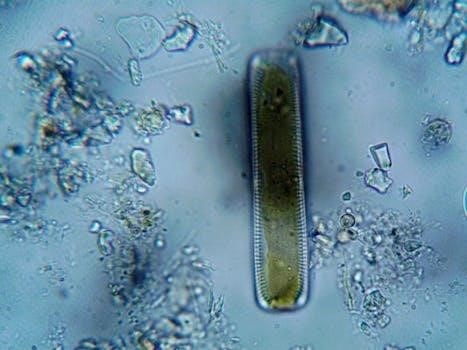Overview of Photosynthesis and Cellular Respiration
Photosynthesis and cellular respiration are vital processes. Photosynthesis converts light into glucose; cellular respiration breaks down glucose to produce energy. These processes are complementary, forming a cycle essential for life on Earth.
Basic Definitions and Roles
Photosynthesis, an anabolic process, is how autotrophs like plants convert light energy, carbon dioxide, and water into glucose and oxygen. Cellular respiration, a catabolic process, occurs in all living organisms; it breaks down glucose and oxygen to produce energy (ATP), releasing carbon dioxide and water. Photosynthesis stores energy, while cellular respiration releases it for cellular activities. These processes are fundamental for energy transfer in ecosystems.

Key Similarities Between Photosynthesis and Cellular Respiration
Both processes involve electron transport chains and chemiosmosis to produce ATP. They also utilize similar molecules and coenzymes, playing a crucial role in energy conversion within cells.
ATP Production Mechanisms
In photosynthesis, ATP is generated using light energy, converting it into chemical energy stored within organic molecules. Conversely, cellular respiration synthesizes ATP by breaking down organic molecules through oxidative phosphorylation. Both processes use the movement of electrons to create a proton gradient which drives ATP synthase, ultimately producing ATP as the primary energy currency of the cell. These mechanisms are fundamental for energy transfer.
Electron Transport and Proton Gradients
Photosynthesis utilizes chlorophyll to donate electrons, establishing a proton gradient across the thylakoid membrane. Similarly, in cellular respiration, electron carriers release electrons, depositing protons into the mitochondrial intermembrane space. These electron transport chains drive proton pumps creating a chemiosmotic gradient. The movement of protons down this gradient is then used by ATP synthase to produce ATP. This common mechanism is the key in both processes.

Key Differences Between Photosynthesis and Cellular Respiration
Photosynthesis is an anabolic process, building glucose and storing energy, while cellular respiration is catabolic, breaking down glucose to release energy. These processes occur in different cell locations at different times.
Anabolic vs. Catabolic Processes
Photosynthesis is an anabolic process; it synthesizes glucose using light energy, storing energy in chemical bonds. It builds complex molecules from simpler ones. Conversely, cellular respiration is a catabolic process. It breaks down glucose, releasing the stored energy. This process converts complex molecules into simpler ones, making energy available for cellular work. The two processes are fundamentally different in their constructive or destructive nature.
Location of Processes in Cells
Photosynthesis occurs within chloroplasts, specifically in the thylakoid membranes and stroma of plant cells and some bacteria. Cellular respiration, in contrast, primarily takes place in the mitochondria of eukaryotic cells. Glycolysis, the initial step of cellular respiration, occurs in the cytoplasm, while the Krebs cycle and oxidative phosphorylation occur in the mitochondrial matrix and inner membrane, respectively. In prokaryotes, cellular respiration occurs within the cytoplasm.
Timing of the Processes
Photosynthesis is primarily a daytime process, requiring sunlight to drive its light-dependent reactions. Cellular respiration, however, occurs continuously, both during the day and night, in all living organisms. Plants, while performing photosynthesis during the day, also undergo cellular respiration at all times to meet their energy needs. Thus, these two processes exhibit different temporal patterns in their operation, reflecting their distinct roles in energy transformation.
Detailed Steps of Photosynthesis
Photosynthesis involves two main stages⁚ light-dependent reactions and the Calvin cycle. The light reactions capture solar energy, while the Calvin cycle uses this energy to convert carbon dioxide into glucose.
Light-Dependent Reactions
The light-dependent reactions occur in the thylakoid membranes of chloroplasts. Chlorophyll absorbs light energy, exciting electrons. Water molecules are split, releasing oxygen, electrons, and protons. These electrons then move through an electron transport chain, creating a proton gradient which drives ATP synthesis. NADPH is also produced in this stage, storing the energy for the next phase.
Calvin Cycle (Light-Independent Reactions)
The Calvin cycle occurs in the stroma of chloroplasts. It uses the ATP and NADPH produced in the light-dependent reactions. Carbon dioxide from the atmosphere is fixed and converted into glucose. This cycle involves a series of enzymatic reactions. The process starts with carbon fixation, followed by reduction and regeneration of the starting molecule to keep the process going.

Detailed Steps of Cellular Respiration
Cellular respiration involves glycolysis, the Krebs cycle, and oxidative phosphorylation. Glycolysis breaks down glucose into pyruvate. The Krebs cycle further processes pyruvate, and oxidative phosphorylation generates ATP. These steps harness energy from glucose.
Glycolysis
Glycolysis, the first stage of cellular respiration, occurs in the cytoplasm. It involves the breakdown of one glucose molecule into two pyruvate molecules. This process generates a small amount of ATP and NADH, which are crucial for later steps. Glycolysis does not require oxygen and is a fundamental pathway for energy production in cells. This initial phase sets the stage for the subsequent stages of cellular respiration.
Krebs Cycle and Oxidative Phosphorylation
The Krebs cycle, also known as the citric acid cycle, follows glycolysis and takes place in the mitochondrial matrix. Pyruvate is further broken down, releasing carbon dioxide and generating ATP, NADH, and FADH2. Oxidative phosphorylation, occurring at the inner mitochondrial membrane, utilizes NADH and FADH2 to produce a large amount of ATP through the electron transport chain and chemiosmosis. This final stage is the most significant for ATP production in cellular respiration.
Relationship Between Photosynthesis and Cellular Respiration
Photosynthesis and cellular respiration are interconnected. Photosynthesis produces glucose and oxygen, which are used in cellular respiration to create energy, carbon dioxide and water. This creates a vital cycle.
Complementary Processes
Photosynthesis and cellular respiration function as complementary processes. Photosynthesis utilizes light energy to synthesize glucose and releases oxygen. Conversely, cellular respiration breaks down glucose, using oxygen, to produce energy, water, and carbon dioxide. The products of one process serve as reactants for the other, creating a continuous cycle of energy and matter transformation that sustains life.
Energy Cycle and Carbon Cycle
Photosynthesis and cellular respiration are integral to both the energy and carbon cycles. Photosynthesis captures solar energy and stores it in glucose, while also removing carbon dioxide from the atmosphere. Cellular respiration releases this stored energy, producing carbon dioxide, which returns to the environment. This reciprocal relationship forms a cycle that drives energy flow and carbon cycling, fundamental for sustaining life on Earth.

Chemical Equations
Photosynthesis⁚ 6CO2 + 6H2O → C6H12O6 + 6O2. Cellular Respiration⁚ C6H12O6 + 6O2 → 6CO2 + 6H2O + ATP. These equations show how the two processes are opposite in chemical terms.
Photosynthesis Equation
The chemical equation for photosynthesis is⁚ 6CO2 + 6H2O + light energy → C6H12O6 + 6O2. This demonstrates that carbon dioxide and water are transformed into glucose and oxygen. It is an endothermic reaction, requiring light for energy input. This process occurs in chloroplasts of plants and some bacteria. Glucose stores the captured solar energy. Oxygen is produced as a byproduct.
Cellular Respiration Equation
The cellular respiration equation is⁚ C6H12O6 + 6O2 → 6CO2 + 6H2O + ATP. This shows that glucose and oxygen are converted into carbon dioxide, water, and energy in the form of ATP. It’s an exothermic reaction, releasing energy. This process occurs in the mitochondria of eukaryotic cells and the cytoplasm of prokaryotes. ATP provides energy for cellular activities.
Electron Acceptors
Electron acceptors play crucial roles. In photosynthesis, NAD+ is the primary electron acceptor. In cellular respiration, NADH acts as the primary electron carrier, accepting electrons for energy production.
NAD in Photosynthesis
In photosynthesis, NAD+ (nicotinamide adenine dinucleotide) functions as a crucial electron acceptor. During the light-dependent reactions, NAD+ accepts high-energy electrons and hydrogen ions, becoming NADPH. This NADPH is essential because it carries the captured energy to the Calvin cycle, where it is used to synthesize glucose from carbon dioxide, ultimately storing solar energy in chemical bonds.
NADH in Cellular Respiration
During cellular respiration, NADH (nicotinamide adenine dinucleotide hydride) plays a key role as an electron carrier. In glycolysis and the Krebs cycle, NAD+ accepts electrons and hydrogen ions, transforming into NADH. This NADH then transports these high-energy electrons to the electron transport chain. These electrons are used to create a proton gradient, which drives ATP production, making NADH essential for energy extraction.
ATP Production
Both photosynthesis and cellular respiration generate ATP, the cell’s energy currency. Photosynthesis uses light energy, while respiration breaks down glucose. Both utilize electron transport chains to produce ATP.
ATP in Photosynthesis
In photosynthesis, ATP is produced during the light-dependent reactions. Light energy is captured by chlorophyll, driving electron transport and creating a proton gradient across the thylakoid membrane. This gradient powers ATP synthase, generating ATP. This ATP is then used in the Calvin cycle to convert carbon dioxide into glucose, storing energy in chemical bonds for later use.
ATP in Cellular Respiration
Cellular respiration generates ATP through a series of steps. Glycolysis produces a small amount of ATP, while the Krebs cycle and oxidative phosphorylation are the major ATP-producing stages. Oxidative phosphorylation uses the electron transport chain to create a proton gradient, which drives ATP synthase, producing a significant amount of ATP. This ATP is used as the primary energy currency of the cell;
